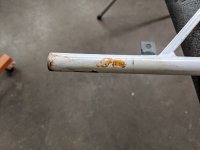Steve Pierce
BENEFACTOR
Graham, TX
I remember several years ago getting some scary pictures of a Super Cub I had rebuilt a year prior and lived in Florida in a hanger. It was amazing what happened with a little detail cleaning. Here is an example of a verticle stabilizer I am working one.
Before a rag and some paint cleaning solvent.


Sent from my Pixel 2 XL using SuperCub.Org mobile app
Before a rag and some paint cleaning solvent.


Sent from my Pixel 2 XL using SuperCub.Org mobile app













